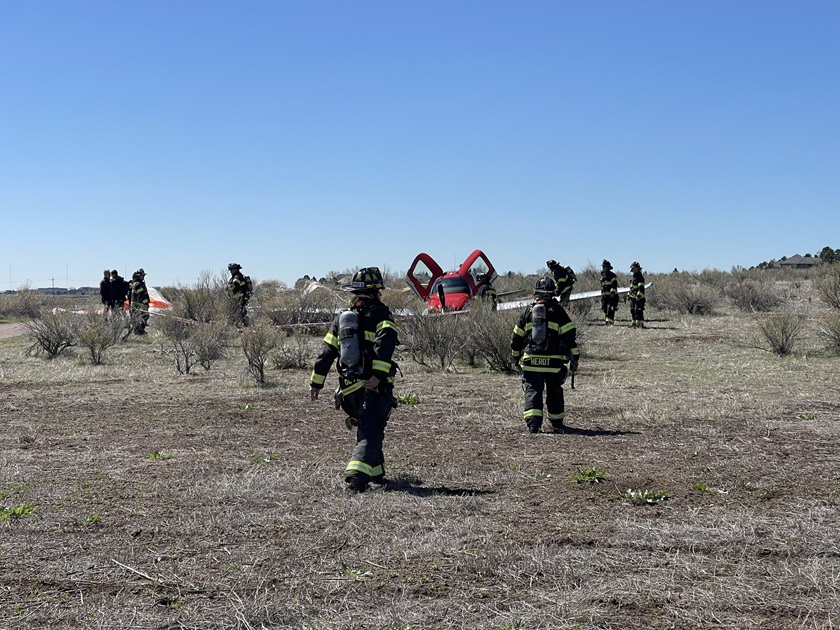Metroliner pilot after midair: 'I'm good, though'
No injuries after Cirrus collides with turboprop, activates CAPS
First responders to a midair collision near Centennial Airport in Denver were pleasantly surprised to find two occupants of a Cirrus SR22 unhurt in a state park after their single-engine piston deployed its airframe parachute to good effect.
First alerted by the tower, firefighters and police also fielded calls from many eyewitnesses who saw the two aircraft collide around 10:25 a.m. Mountain time on May 12. Their reports, along with radio traffic recorded by LiveATC.net, and many photographs and videos posted on social media provide an unusually detailed early account of the collision that badly damaged a Fairchild Swearingen Metroliner operated by Key Lime Air, ripping several feet off the top of the turboprop’s fuselage. The resulting damage reminded Arapahoe County Sheriff’s Deputy John Bartmann of Aloha Airlines Flight 243, which landed safely on April 28, 1988, after decompression and structural failure in flight tore off much of the upper fuselage. Flight attendant Clarabelle Lansing was killed in the Aloha Airlines incident, but the Key Lime Air Metroliner was hauling cargo and landed with nobody hurt, or even apparently fully aware that the aircraft had been struck by a Cirrus SR22 about 30 seconds after the flight was cleared to land on Runway 17L.
“Tower, that was a definite midair on short final,” another pilot reported as the Metroliner was landing, shortly after which the tower controller inquired if Key Lime 970 required assistance.
“I’m gonna taxi off here, and I think I’ll just park over at Signature,” the pilot responded. “I’m good, though.”
Traffic for the shorter, parallel Runway 17R was being handled by a different controller on another frequency. That controller was also handling several aircraft, and advised the Cirrus about two aircraft to watch for, a Cessna and the Metroliner. The acknowledgement “traffic in sight” was the last transmission from the Cirrus, and it is not clear if he was referring to the Cessna, the Metroliner, or both.
“Cirrus 6 Delta Juliet do not overshoot the final,” the controller advised, and followed almost in the same breath by: “Cirrus 6 Delta Juliet, do you require assistance?” After a brief pause: “Cirrus 6 Delta Juliet, if you hear this transmission, we have emergency vehicles your direction.”
Among the responders was Eric Hurst, a public information officer for South Metro Fire Rescue, who said in a telephone interview that the rescue crews arrived to find two occupants already out of the Cirrus under their own power, and both of them declined medical attention. According to local media accounts, the Cirrus belongs to Independence Aviation, a flight school and Cirrus Training Center.
The collision occurred over Cherry Creek State Park, Hurst said, which includes an 880-acre reservoir that is a popular boating destination, along with various hiking and bicycle trails from which witnesses had a clear view of both the violent collision and the surprisingly uneventful aftermath.
“We’re all really happy that it wasn’t worse,” Hurst said. While fire-and-rescue services were not required, Hurst and fellow responders did visit the airport after securing wreckage found in the park on behalf of the FAA and the NTSB. From the point of collision to the runway, the Metroliner overflew many buildings and people, including one South Metro Fire Rescue station, Hurst said. He said falling debris or a crash of the damaged turboprop would likely have led to much more disastrous consequences. “Obviously, we’re super grateful that didn’t happen.”
Hurst said examination of the damaged Metroliner made it all the more amazing that nobody was hurt. “Looking at it is a head-scratcher, to see that amount of damage on an aircraft that was able to land without incident.”
Bartmann, the sheriff’s deputy, shared that view: “The fact that that pilot was able to land that aircraft in the condition it was, is shocking,” Bartmann said. “I mean, I’m surprised.”
He said others at the airport had a similar assessment: “We heard things like, ‘that pilot needs to buy a lottery ticket.’”
Bartmann said several cellphone videos of the incident posted online within hours of the event document the SR22 descent under the canopy of its airframe parachute. He said he could not personally confirm reports that one or more witnesses in the state park approached the Cirrus pilot bearing pieces of one or the other aircraft.





